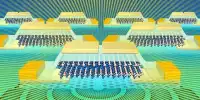Research from the University of California, San Diego has taken our machine-enhanced vision a step further in cyber-style. Writing in the Journal of Advanced Functional Materials, a team of soft material mechanics led by Shengqiang Cai described the science behind a robotic lens designed in proof-of-concept practice. Flick twice to increase zoom. Repeat to zoom back. Turn your eyes left or right and the lenses will follow.
According to the authors of the study, most soft robots are controlled manually or using pre-written code, but the robotic lens is different. It uses a fancy human-machine interface controlled by eye movement and the resulting electrocographical signals. The new lenses embrace the power of soft robots or soft machines. These are robots made of highly compliant materials that mimic the behavior of living things. For example, you may have a soft gripping machine that can catch a brittle egg like a raw egg – a job that would be more challenging for a conventional gripper made of hard material. In this case, the soft robot mimics some mechanism of the human eye.
This electrical potential can be measured whenever you remove your eye or eyelid and it is these measurements that robotic lenses use. Even when your eyes are at rest, a static electrical potential exists between the cornea and the bronchial membrane. The lens itself is made of salt water or saline, which is bound in two electronic polymer films and is controlled by five electrodes placed around the eye that detect the electrical potential of the eye. This allows lenses to stretch and reduce thickness when an electrical potential is detected, effectively enabling the user to zoom in and out by flashing. Since the lenses are made of soft materials, the relative change in focal length can be as large as 32 percent – making it a great impressive zoom feature.
For example, it can also put you at risk for errors in movement recognition, which can result in activities outside of the user’s intent or nothing. But the prospect is exciting. Due to the fact that electrical potential exists without vision, it could one day be used as a visual synthesis, as well as incompatible glasses or remote-powered robotics. The design could not be created perfectly – in its current shape, it cannot be moved diagonally, only vertically and horizontally.















